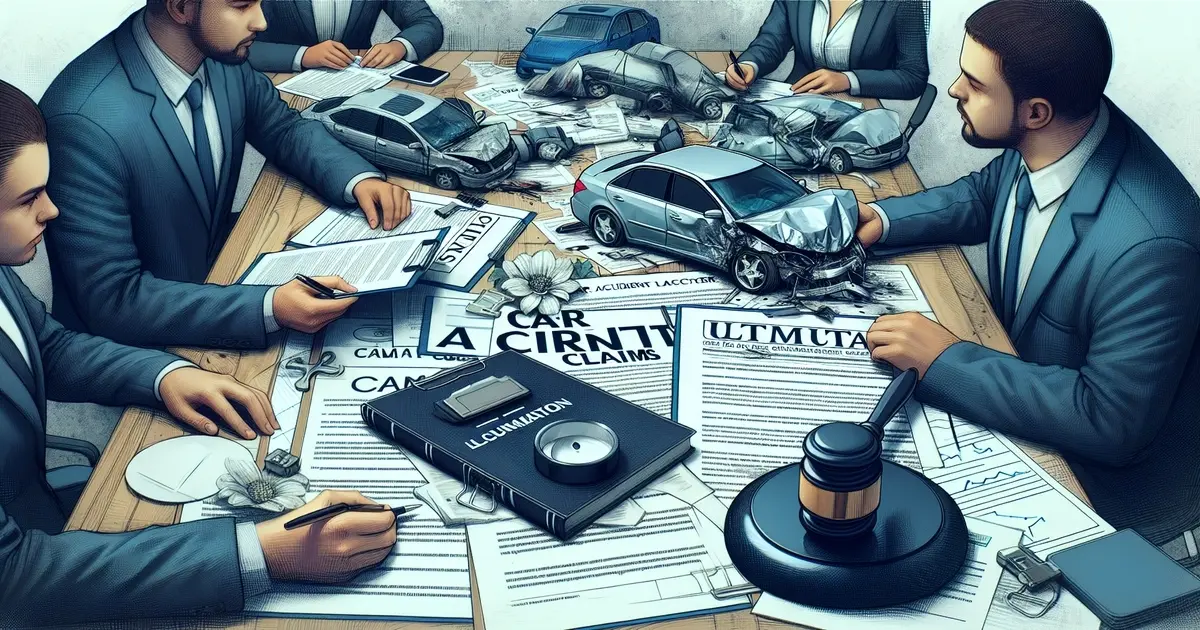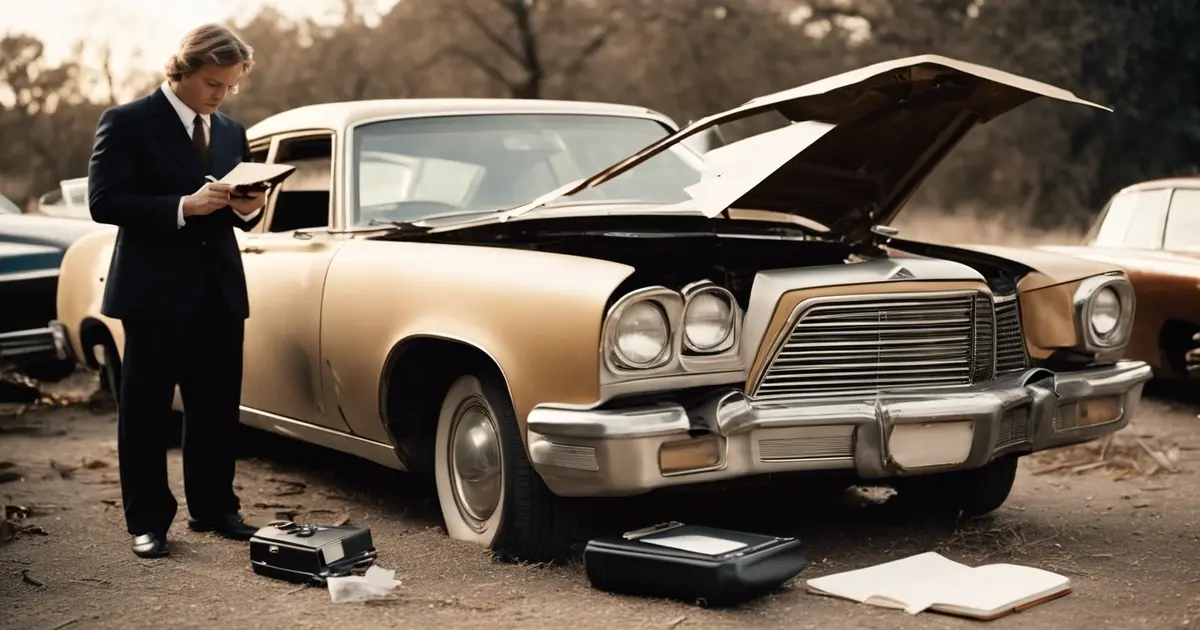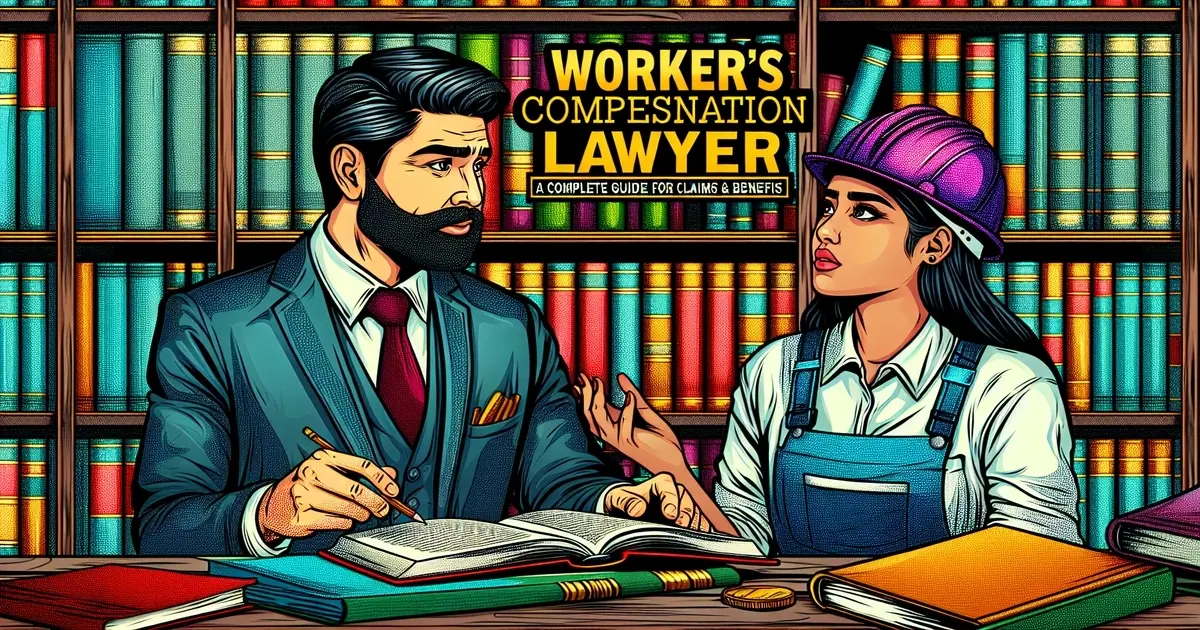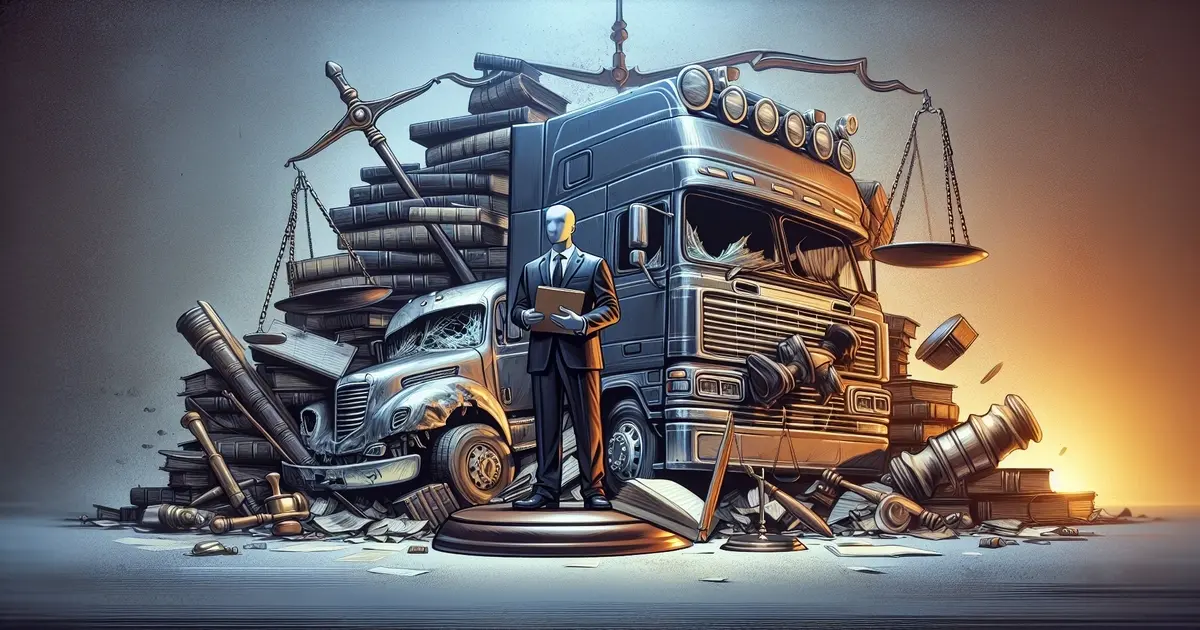Car Accident Lawyer: Ultimate Guide Car Accident Claims
Navigating the aftermath of a car accident may feel like trying to find your way through a maze without a map, especially if pedestrians are involved and you're on your way to work from the side street. On one side, you're grappling with physical injuries, emotional stress, and possibly even property damage from car crashes or at work, according to the law.
Conversely, a complex legal landscape in the West may require law expertise to maneuver effectively. This is where the role of a skilled car accident lawyer becomes indispensable. They don't just guide you through the legal maze; they advocate for your rights, aiming to secure the compensation you deserve. With their law knowledge and experience, they transform what seems like an impossible challenge into a manageable process, ensuring you're not left to navigate this daunting journey alone in the West, which may initially seem overwhelming.
Table Of Contents
Identifying Causes of Car Accidents
Distracted Driving
Distracted driving is a significant cause of car accidents, whether in the West or elsewhere, and it often violates the law. Distracted driving involves any activity that diverts attention from driving. This includes talking or texting on the phone, eating and drinking, talking to people in the vehicle, or fiddling with the stereo, entertainment, or navigation system. In the West, the law may address these behaviors.
Drivers lose focus on the road. This lapse in attention may lead to missing critical cues like stop signs or red lights, resulting in law-related accidents.
Speeding
Exceeding speed limits is another significant factor contributing to road mishaps. Speeding reduces a driver's ability to steer safely around curves or objects in the roadway. It extends the distance necessary to stop a vehicle and increases the distance it travels while the driver reacts to a dangerous situation.
Higher speeds make accidents more severe. They lead to more serious injuries or even fatalities.
Driving Under Influence
Alcohol impairs thinking, reasoning, and muscle coordination. These abilities are essential in operating a vehicle safely. As alcohol content in one’s bloodstream increases, so does the risk of an accident.
Driving under the influence is illegal and dangerous. It significantly raises the chances of causing an accident on highways and local roads.
Reckless Driving
Reckless driving includes changing lanes too quickly, acting aggressively on the road, and not obeying traffic signals. Such behaviors endanger other road users.
Reckless drivers often ignore traffic laws. They put everyone at risk with their unpredictable actions.
Weather Conditions
Bad weather conditions such as rain, snow, fog, and ice significantly affect driving safety. Wet roads reduce tire traction, leading to sliding off or into other vehicles.
Fog decreases visibility. Drivers find it hard to see other vehicles until it's too late to avoid them.
Road Infrastructure
Poorly maintained roads also contribute to car accidents. Potholes, missing guardrails, and unclear signage can confuse drivers or damage vehicles, leading to loss of control.
Effective highway safety measures include regular maintenance and clear markings for all road users.
Exploring Common Types of Car Accidents
Rear-End Collisions
Rear-end collisions are among the most frequent types of car accidents. They often occur when a vehicle fails to stop, crashing into the one in front. These accidents are common in heavy traffic areas and at stop lights. They can lead to severe injuries, including whiplash.
Drivers should maintain a safe distance from the car ahead to prevent these incidents. Awareness and quick reaction times also play crucial roles in avoiding rear-end collisions.
T-Bone Crashes
T-bone crashes happen when the side of one vehicle is hit by the front or rear of another, forming a "T" shape. Intersections are hotspots for this type of accident, especially when drivers ignore traffic signals or fail to yield right-of-way. The impact of T-bone crashes can be severe, often resulting in significant injuries or fatalities.
To minimize risks, drivers must approach intersections cautiously and respect traffic laws.
Highway Accidents
Highway accidents involve multiple vehicles and occur at high speeds. Factors include lane merging errors and high-speed rear-endings. Due to the velocity involved, these incidents are dangerous and can result in multi-car pile-ups.
Staying alert on highways and practicing defensive driving can help avoid such accidents.
Seasonal Variations
The time of year can influence the likelihood of certain types of car accidents. Winter months bring ice and snow, increasing the risk of sliding into another vehicle or object. Summer sees more young drivers on the road, which can lead to higher accident rates.
Drivers should adjust their driving habits according to seasonal challenges to stay safe.
Time of Day Differences
Accident types also vary by time of day. Nighttime reduces visibility, leading to more collisions with pedestrians or fixed objects. Early morning and late afternoon see peak traffic hours, raising the chances of rear-end collisions and highway accidents.
Being extra cautious during these times can significantly reduce accident risks.

Bicycles in Car Accident Scenarios
Legal Rights
Cyclists have specific legal rights on the road. They must follow traffic laws, just like car drivers. However, when a collision occurs, determining fault can be complex.
Cyclists often face challenges in proving their right to use the road equally. They may encounter drivers unaware of cyclists' rights or neglect them altogether. In these situations, a car accident lawyer can provide invaluable assistance. These legal professionals understand the nuances of traffic law concerning cyclists. They help victims navigate the aftermath of an accident.
Common Injuries
Injuries from bicycle-car collisions can be severe. Cyclists lack the protective shell that cars offer their occupants, making them more vulnerable to injury.
Common injuries include broken bones, head trauma, and road rash. Recovery can be long and costly, involving medical bills and potentially lost wages. A skilled car accident lawyer can assist in securing compensation for these damages. They work to ensure injured cyclists receive the financial support they need for recovery.
Preventative Measures
Both cyclists and drivers can take steps to prevent accidents. Awareness and caution are essential.
Cyclists should wear visible clothing and use lights at night. They should also signal their intentions clearly to drivers. On the other hand, drivers need to give cyclists space on the road and check mirrors before turning or opening doors.
Despite precautions, accidents can still happen. When they do, having a knowledgeable car accident lawyer is crucial for effectively navigating legal proceedings.
Insurance Claims
Dealing with insurance after a bicycle-car collision can be daunting. Cyclists may find themselves battling for fair coverage against powerful companies.
A car accident lawyer understands how insurance policies apply in these scenarios. They advocate for their client's best interests during negotiations, ensuring that cyclists receive appropriate compensation for their injuries and damages without being overwhelmed by the process.
Navigating Car Accidents and Insurance
Filing Claims
The first step after a car accident is to contact your insurance company. You'll need to provide detailed information about the incident, including the date, time, location, and how it occurred—gather evidence at the scene. Take photos of the damage and collect contact details from witnesses. This helps when filing your claim.
Insurance companies require a police report if there are injuries or significant damage. Make sure you have this document before contacting your insurer.
Fault Determination
Fault plays a critical role in insurance claims. It affects who is responsible for damages and injuries. Traffic laws guide fault determination. For instance, if drivers were texting or not paying attention, they were likely at fault.
In some states, fault is shared among drivers involved in an accident. This can impact compensation amounts. A car accident lawyer can help understand these nuances.
Knowing local traffic laws is beneficial. It ensures you drive safely and avoid actions that could lead to accidents.
Insurance Adjusters
Dealing with insurance adjusters requires patience and strategy. They assess claims to determine payouts. Here are tips for securing a fair settlement:
- Be prepared with all necessary documents and evidence.
- Understand your policy's coverage limits.
- Don't accept the first offer if it seems too low.
Remember, adjusters aim to settle claims quickly and economically for their company.
Legal Assistance
Sometimes, insurance doesn't cover all expenses like medical bills or lost wages. This is where legal options come into play.
A car accident lawyer can navigate complex legal processes. They ensure you receive fair compensation beyond what insurance offers.
They can also handle negotiations with insurance adjusters on your behalf.
The Significance of Proving Negligence
Duty Breach
To establish negligence in a car accident, it's crucial to demonstrate that the other party breached their duty. Every driver must operate their vehicle safely and abide by traffic laws. When they fail to do so, they breach this duty.
Proving this breach involves gathering evidence like traffic camera footage or eyewitness accounts. This evidence can show, for example, if the other driver was speeding or ignoring traffic signals.
Causation Link
The next step is to connect this breach of duty directly to the accident. It's not enough to show that the other driver was acting recklessly; one must prove that their actions were the direct cause of the collision.
This often requires technical analysis of the accident scene, including skid marks and vehicle damages. Expert witnesses might be called upon to explain how these factors indicate causation.
Damage Evidence
Finally, proving negligence requires demonstrating that the accident resulted in actual damages. This includes physical injuries, property damage, and any other losses incurred due to the accident.
Medical records and repair bills serve as critical evidence here. They provide tangible proof of the injuries and financial losses from the crash.
Importance of Evidence
Gathering solid evidence is paramount in establishing fault in a car accident case. Police reports offer an official account of events and can indicate violations committed by the involved parties. Witness statements add personal observations, lending credibility to claims about how the accident occurred.
Photos from the scene capture immediate aftermath details that might be forgotten or overlooked later. Together, these elements build a strong negligence case.
Influence on Compensation
Negligence directly influences compensation amounts awarded in car accidents. If one can prove that the other party was at fault due to negligence, one's claim for higher compensation will be strengthened.
This compensation covers medical expenses, lost wages, pain and suffering. Claims may be significantly reduced or outright denied without clear evidence of negligence.
Compensation Following a Car Accident
Medical Costs
After a car accident, victims often face steep medical expenses. These costs can include emergency room visits, surgeries, and long-term rehabilitation. A lawyer can help recover these expenses.
Victims need immediate medical attention after an accident. This ensures their injuries are documented from the start. Documentation is crucial for claiming compensation later.
Lost Wages
Many victims cannot work due to their injuries. They may seek compensation for lost wages.
The amount recovered depends on the victim's salary and when they've been out of work. A skilled legal team can calculate this accurately.
Non-Economic Damages
Pain and suffering fall under non-economic damages. These are harder to quantify but equally important.
Victims may experience significant emotional distress post-accident. The law recognizes this pain and offers compensation accordingly.
Punitive Damages
In cases of egregious negligence, courts may award punitive damages. These serve as punishment to the negligent party and a deterrent against future misconduct.
Not all cases qualify for punitive damages. Proving extreme carelessness or intentional harm by the other party is required.
Essential Steps Post-Car Accident
Ensure Safety
First, ensure everyone's safety. Move to a safe location if possible. This prevents further accidents.
Next, check for injuries and call emergency services if anyone is hurt. It's crucial to prioritize health and safety above everything else.
Call Police
Always call the police, even for minor accidents. They document the scene and create an official report. This is vital for the legal process later on.
The police report serves as an objective account of the incident. It can significantly support your case when seeking compensation.
Gather Evidence
Start by taking photos of the accident, including all vehicles involved and any visible damages. Capture wide shots to show the accident context and close-ups for details.
Collect contact information from witnesses. Their statements can be robust evidence in your favor.
Seek Medical Attention
Visit a doctor immediately after the accident, even if you feel fine. Some injuries take time to manifest.
A medical report links your injuries directly to the accident. This is crucial when claiming compensation for medical expenses.

Timeline for Car Accident Settlements
Initial Steps
After the essential steps post-car accident have been taken, understanding the timeline for car accident settlements becomes crucial. The process begins when the injured party, often with a lawyer's help, files a claim against the at-fault driver's insurance company.
The filing usually happens within days or weeks after the accident. This quick action is vital to preserve evidence and strengthen the case.
Investigation Phase
Once a claim is filed, an investigation into the accident's details starts. This phase can last from a few weeks to several months, depending on the case's complexity and the fault's clarity.
Insurance companies review police reports, medical records, and any other relevant documentation during this time. They might also interview witnesses. The goal is to understand fully what happened and who bears liability.
Negotiation Process
If liability is established after the investigation, negotiations between your lawyer and the insurance company begin. This stage varies significantly in length. It can be as short as a few weeks if both parties agree on damages quickly.
However, if there are disputes about liability or compensation amount, it can extend over several months or even years. Your legal representation plays a pivotal role in advocating for your best interests and aiming to expedite the settlement.
Litigation
If negotiations stall or fail, your case may proceed to litigation. Filing a lawsuit does not mean you will go to trial; many cases settle before reaching that point. However, entering this phase indicates preparedness for court, which can add months or years to the timeline.
Litigation involves discovery periods, motions, and a trial, each adding time but potentially increasing the settlement amount.
Final Settlement
The final settlement marks the end of this journey. Once agreed upon by all parties involved, paperwork is signed, and compensation is disbursed. From start to finish, this process can take anywhere from a few months to several years.
Case complexity, insurance company cooperation, and legal representation quality significantly influence this duration.
Common Injuries from Car Accidents
Whiplash Injuries
Whiplash is a common injury in car crashes. It happens when the head is suddenly jerked forward and then backward. This can damage the neck's muscles and ligaments.
Victims often feel pain and stiffness. Some also experience headaches or dizziness. Recovery might take weeks or even months.
Broken Bones
Car accidents can lead to broken bones, especially in the arms, legs, and ribs. The force of a crash can cause severe fractures that require surgery.
Recovery times vary widely. Some people might need physical therapy to regain their entire movement.
Traumatic Brain Injuries
Severe injuries like traumatic brain injuries (TBIs) are devastating. They occur when a blow to the head disrupts normal brain function.
TBIs can have long-term effects on memory, behavior, and emotion. They may also lead to permanent disability.
Long-Term Impact
The long-term impact of serious injuries cannot be overstated. Victims might face chronic pain or cognitive issues.
These problems can affect their quality of life and ability to work. It underscores the importance of seeking immediate medical attention after an accident.
Comprehensive Evaluation
Getting a comprehensive medical evaluation after a car accident is crucial. This helps identify any injuries that might not be immediately apparent.
Early treatment can prevent complications and promote better recovery outcomes. It also provides necessary documentation for any legal claims related to the accident.
Final Remarks
Understanding the nuts and bolts of car accidents is crucial—from their causes and standard types to the nitty-gritty of dealing with insurance and legal battles. You've dived deep into how negligence is proven, what compensation you might expect, and the essential steps to take post-accident. Equipped with this knowledge, navigating the aftermath of a car accident becomes less daunting. Remember, injuries from car accidents vary widely; prioritizing your health and legal rights is paramount.
Don't let the complexity of car accident settlements intimidate you. Seeking professional help can make a world of difference. A skilled car accident lawyer can guide you through this maze, ensuring your rights are protected every step of the way. If you've been in an accident, consider reaching out for expert advice sooner rather than later. Your peace of mind and financial stability could depend on it.
Frequently Asked Questions
What are the common causes of car accidents?
Car accidents often result from speeding, distracted driving, and impaired driving. Identifying the cause is crucial for any legal case.
What types of car accidents typically occur?
Rear-end collisions, T-bone crashes, and head-on collisions are among the most common types of car accidents.
Can bicycles be involved in car accident scenarios?
Yes, bicycles can be involved in car accidents, especially in urban areas where sharing the road is necessary.
How does insurance play a role in car accidents?
Insurance is vital to covering damages and injuries after a car accident. Navigating claims correctly ensures fair compensation.
Why is proving negligence, including reckless and distracted driving, necessary in a car accident case for highway safety and preventing severe injuries?
Proving negligence is essential to establish fault and secure compensation for damages and injuries sustained in the accident.
What compensation can be expected after a car accident?
Compensation may cover medical bills, lost wages, and pain and suffering. The amount depends on the accident's impact on your life.
What are the essential steps to take post-car accident to ensure highway safety and prevent severe injuries caused by reckless or distracted driving?
Ensure safety first, then exchange information, document the scene, seek medical attention, and contact a lawyer to protect your rights.
What is the typical timeline for a car accident settlement in the West during work, which may involve distracted driving?
Settlement timelines vary but generally range from several months to over a year, depending on case complexity.
What are common injuries from car accidents?
Injuries can range from whiplash and broken bones to more severe conditions like traumatic brain injuries (TBI) and spinal cord injuries.
Related Post
Medical Malpractice Lawyer
Navigating the complex waters of medical malpractice requires a skilled advocate by your side. The history of medical malpractice law stretches back centuries, evolving from simple negligence cases to intricate legal battles involving cutting-edge medical technology and procedures.
Read MoreWorkers' Compensation Lawyer
Have you ever wondered why navigating the maze of workers' compensation claims, accidents, wage replacement, and social security disability feels like an uphill battle with a firm?
Read MoreTruck Accident Lawyer
Every year, thousands find themselves in the middle of a nightmare on the road, with tractor-trailer truck accidents leading to devastating outcomes and attorneys ready to fight for them.
Read MoreMesothelioma Lawyer Guide
Navigating through the legal maze of mesothelioma cases, a form of asbestos litigation, requires a skilled lawyer who understands the disease's complexity and has a track record of securing justice for victims.
Read MorePersonal Injury Law
Navigating the complexities of personal injury law, court decisions, and alternative dispute resolution can feel like trying to find your way out of a labyrinth without a map for the injured party, emphasizing the importance of reasonable care.
Read More





